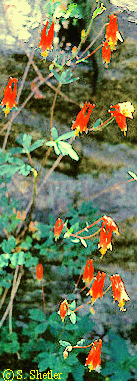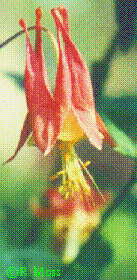Wild Columbine (Aquilegia canadensis)
- Other Names
 Canada or Canadian
columbine, honeysuckle, meetinghouses, rock-bells, and, simply, columbine.
Canada or Canadian
columbine, honeysuckle, meetinghouses, rock-bells, and, simply, columbine. - Derivation of Latin name
- Aquilegia is a Latin word of uncertain origin; probably, it was derived from aquilegus,
meaning "water collector," in allusion to the fluid at the base of the petal's
spur, but perhaps from aquila, an eagle, because the spurs suggested the talons of
an eagle to Linnaeus. "Columbine" comes from the Latin for dove (columba),
the spurred petals perhaps having suggested a ring of doves around a fountain.
- Description
- Few spring wildflowers possess such poetic beauty or evoke such sentiment as wild
columbine (Aquilegia canadensis). Its flowers, as one writer puts it, have airy
grace and ornamental poise, dancing, as another says, in red and yellow petticoats to the
rhythm of the breeze along rock ledges. In the wild or in the garden, this widely
distributed, singular beauty of rocky woodlands and cliffs ranks high in Virginia's
treasury of native wildflowers.
Aquilegia is a genus of the buttercup family, the
Ranunculaceae, comprising worldwide about 60 genera and 2500 species. In the United States
and Canada, 18 genera and over 250 species are indigenous; especially notable genera are Anemone
(anemones and windflowers), Aquilegia (columbines), Clematis, Delphinium
(larkspurs), Ranunculus (buttercups), and Thalictrum (meadow-rues). The
distribution of the family is centered in the cooler temperate regions of the northern
hemisphere. Most species are herbaceous perennials; a few are shrubs or vines. The
buttercup family is important for its many ornamentals, including anemones, buttercups,
clematises, columbines, globeflowers, hellebores, larkspurs, and peonies.
A circumboreal group of about 70 species, the genus is
represented in North America by 20 native species. Nearly every state has at least one
species. Many Eurasian species and hybrids are cultivated in North America, but only the
European A. vulgaris, which has many horticultural varieties and hybrids, escapes
sometimes from cultivation and naturalizes here. Columbines are highly variable, and even
the most distantly related species hybridize freely in nature as well as in the garden,
making it difficult to delimit the species within the genus. Wild columbine is the only
species native to eastern North America and the only species in Virginia, native or
naturalized.
Wild columbine is a delicate but hardy perennial herb with thin,
woody rhizomes and slender, much-branched stems. The plants typically grow 1-2 feet tall,
but may reach 3 feet or more. The delicate leaves are both basal and alternate on the stem
and 1-3 times compound, with each division in threes. The leaves at the base and on the
lower stem are large (to a foot long) with long primary and secondary stalks but become
much reduced upward. The small leaflets, in threes, are more or less oval with rounded
teeth or lobes.
The showy, spurred flowers, nodding at the tips of slender
branches with the spurs pointing upward, are 1-2 inches long and bright red to pinkish
with yellow insides. The flower consists of five tubular, red petals with yellow lips
alternating with five flat, reddish sepals; numerous yellow stamens, projecting downward
like a golden tassel well beyond the petals and sepals; and five green pistils with long
thin styles, surrounded by the stamens. The distinctive petals, which look like tiny
cornucopias,  extend
backward into long hollow spurs ending in nectar-filled knobs. Not all of the stamens are
fertile. The five erect, long-beaked fruits that mature from the pistils are dry pods,
called follicles, which split along the inner side to shed their numerous, shiny black
seeds.
extend
backward into long hollow spurs ending in nectar-filled knobs. Not all of the stamens are
fertile. The five erect, long-beaked fruits that mature from the pistils are dry pods,
called follicles, which split along the inner side to shed their numerous, shiny black
seeds.
As the long, nectar-bearing spurs indicate, the flower is adapted
to long-tongued nectar-feeders, notably hawk moths and hummingbirds. The constriction in
the funnel-shaped spur just below the secreting bulbous tip undoubtedly prevents small
bees from getting at the nectar. The association between wild columbine and the eastern
North American ruby-throated hummingbird, which is attracted to red flowers, is well
known. Wherever there is a colony of columbines, the hummingbird is likely to be seen
regularly, as, in the words of one person, it "flashes like thought" among the
flowers, draining all the inverted cornucopias. The yellow inside the petal may serve as a
guide to the nectar.
Nectar-feeding visitors and bees visiting for the pollen are the
agents of cross- pollination. The flower is adapted to prevent self-pollination. The
stamens mature first, starting from the outside ring and moving toward the center,
shedding all their pollen before the styles emerge at the mouth of the flower and spread
their feathery stigmas to receive pollen. Even if the male and female phases overlap
briefly, pollen cannot fall upward from the longer stamens onto the shorter styles in the
hanging flowers.
- Propagation
- Wild columbine is an old-fashioned garden plant, cultivated in Europe and America since
the mid-1600s. It's easy to grow from seeds or from divisions of rootstocks in the spring.
It prefers a moist, well drained, slightly acid, sandy loam with organic matter but will
grow in a wide range of soils, including clays, especially if they drain well and have
organic matter added. It does best in light shade but will tolerate full sun if daytime
temperatures are not too hot. Sow seeds from spring to early summer or in flats during
winter for transplanting outdoors in spring. Newly ripened seeds will germinate without
treatment if sown outdoors in seedbeds or flats. Nursery stock should be set out in the
spring or in the fall when dormant. Seedlings do not flower the first season.
With its dainty leaves and floral bells, it is the perfect
complement to a creviced wall or rock garden, a must in the hummingbird garden, and a
graceful highlight to a perennial border, where its airy, understated elegance contrasts
starkly with the loud, robust beauty of the garden columbine, A. vulgaris. Although
in nature individual plants may persist for years, under garden conditions individuals may
last only a few years. Wild columbine readily seeds itself, however, and new plants spread
rapidly in the garden. Several cultivars are available in the nursery trade.
- Other information
- Native Americans used infusions from different parts of the plant for a variety of
ailments from heart trouble to fever and even as a wash for poison-ivy. When pulverized,
the seeds, a commodity of intertribal commerce, were rubbed on the hands by men as a love
charm and also used in some tribes as a man's perfume.
The chief threats to wild columbine, which is still common and
not in imminent danger of extirpation in Virginia, are habitat destruction and collecting
in the wild. For the wildflower gardening enthusiast or dealer, it is a charmer and a
temptation whenever it is found, and some of its favorite habitats are the unprepossessing
waysides so little cherished and often destroyed.
- Where it grows
- Its native range is from Quebec to Saskatchewan south to Florida and Texas.

 Canada or Canadian
columbine, honeysuckle, meetinghouses, rock-bells, and, simply, columbine.
Canada or Canadian
columbine, honeysuckle, meetinghouses, rock-bells, and, simply, columbine.  extend
backward into long hollow spurs ending in nectar-filled knobs. Not all of the stamens are
fertile. The five erect, long-beaked fruits that mature from the pistils are dry pods,
called follicles, which split along the inner side to shed their numerous, shiny black
seeds.
extend
backward into long hollow spurs ending in nectar-filled knobs. Not all of the stamens are
fertile. The five erect, long-beaked fruits that mature from the pistils are dry pods,
called follicles, which split along the inner side to shed their numerous, shiny black
seeds.